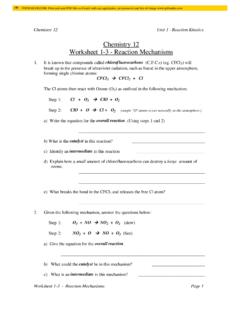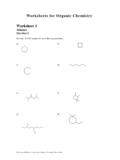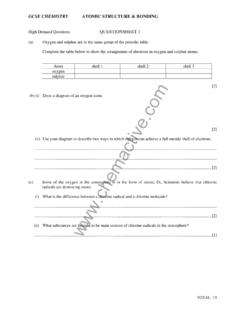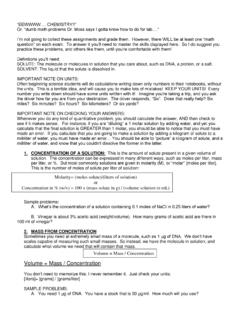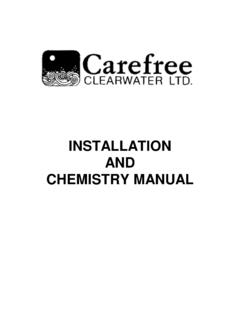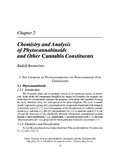Transcription of Chemistry 12 Tutorial 10 Ksp Calculations - D Colgur
1 Chemistry 12 Unit 3 - Solubility of Ionic Substances Tutorial 10 - Ksp Calculations Page 1 Chemistry 12 Tutorial 10 Ksp Calculations Welcome back to the world of Calculations . In Tutorial 10 you will be shown: 1. What is meant by Ksp . 2. How to write a "Ksp expression" from a net ionic equation. 3. How to calculate the solubility of an ionic substance in moles/L or in grams/L, given the value of Ksp . 4. How to calculate the value of Ksp , given the solubility of an ionic substance. ** What is Ksp ? Ksp is really nothing new.
2 It's simply the equilibrium constant (Keq) for an ionic substance dissolving in water. For example, for the substance, CaCO3(s), when it dissolves in water, forms the ions Ca2+ and CO32-. The equilibrium net-ionic equation for this is: CaCO3(s) Ca2+(aq) + CO32-(aq). The equilibrium constant (Keq ) expression for this reaction is: Keq = [Ca2+] [CO32-] (Remember that the [CaCO3] is not included in the expression because it is a solid.) Remember that the solubility was defined as the equilibrium concentration of a substance in water.
3 But when ionic compounds dissolve in water, you always get at least 2 ions formed. (In this case the Ca2+ and the CO32-.) Multiplying the concentrations of the two ions (multiplication gives a "product"), as you can see, gives the Keq expression: Keq = [Ca2+] [CO32-] Keq can be thought of as the "product of the solubility s of the two ions". So for ionic compounds dissolving in water, the Keq is given a special name: It is called "solubility product constant", or Ksp.
4 Chemistry 12 Unit 3 - Solubility of Ionic Substances Tutorial 10 - Ksp Calculations Page 2 Writing the Ksp expression from the Net-Ionic Equation. There's really nothing new to this. Just remember to leave out the solid. (Include the aqueous ions only) and to change coefficients in the balanced equation to exponents in the Ksp expression. Here are a couple of examples: The net-ionic equation for lead (II) chloride dissolving is: PbCl2(s) Pb2+(aq) + 2Cl-(aq) The Ksp expression for this is: Ksp = [Pb2+] [Cl-]2 (Notice that the "2" in front of the Cl- in the equation becomes an exponent in the Ksp expression.)
5 It does NOT go in front of the Cl- in the Ksp expression!) The net-ionic equation for silver sulphate dissolving is: Ag2SO4(s) 2Ag+(aq) + SO42-(aq) The Ksp expression would be: Ksp = [Ag+]2 [SO42-] I don't think you should have any more trouble with these as long as you follow the simple rules: 1. leave out the solid. (Include the aqueous ions only) 2. change coefficients in the balanced equation to exponents in the Ksp expression. ** Calculating Solubility given Ksp . The first type of calculation we will look at is how to calculate the solubility of a substance in moles per litre (M), given the value of Ksp.
6 NOTE: We only consider the Ksp and the solubility of substances which have "Low Solubility" on the Solubility Table. These are also called "Slightly Soluble Salts" For these Calculations , we can define molar solubility as the moles of the substance which will dissolve in one litre of solution to form a saturated solution. On the next page, you will be shown how to calculate the molar solubility of AgCl from the Ksp. Chemistry 12 Unit 3 - Solubility of Ionic Substances Tutorial 10 - Ksp Calculations Page 3 First we obtain a sheet entitled Solubility Product Constants at 25 C This has Ksp s for many of the Low Solubility Compounds listed.
7 Always have this table with you on a test! So, we find that the Ksp for AgCl = x 10-10 The net-ionic equation for the substance, AgCl dissolving in water is: -s AgCl(s) Ag+(aq) + Cl-(aq) The number of moles of AgCl which dissolve in one litre can be defined as "s". (This is the molar solubility.) Notice, that this is written as "-s" above AgCl in the equation. This is because when you dissolve AgCl in water, the amount of solid will go down by "s" because that much dissolves.
8 The -s is the same thing as [C] or change in concentration in an ICE table. Now by mole ratios, you can see, that in this case [Ag+] will increase by "s" as the AgCl dissolves. Also, the [Cl-] will also increase by "s". (The coefficients of Ag+ and Cl- are both "1".) 1/1 -s ------> +s AgCl(s) Ag+(aq) + Cl-(aq) 1/1 and -s -------------------> +s AgCl(s) Ag+(aq) + Cl-(aq) so we have.
9 -s +s +s AgCl(s) Ag+(aq) + Cl-(aq) where "s" is the moles/L of AgCl which dissolve. The Ksp expression for this process is: Ksp = [Ag+] [Cl-] What we do now is "plug in" the values of [Ag+] and [Cl-] in terms of "s". These are the expressions written on top of the net-ionic equation: [Ag+] = s and [Cl-] = s (we don't need to write the "+" signs) Chemistry 12 Unit 3 - Solubility of Ionic Substances Tutorial 10 - Ksp Calculations Page 4 x 10-10 Since: Ksp = [Ag+] [Cl-] Ksp = (s) (s) or Ksp = s2 Now we can solve for s.
10 Remember we found from the Ksp table that the value for Ksp = x 10-10 So s2 = x 10-10 or s = = x 10-5 M Since "s" was defined as the molar solubility of AgCl: -s +s +s AgCl(s) Ag+(aq) + Cl-(aq) where "s" is the moles/L of AgCl which dissolve. We can say, the molar solubility of AgCl is x 10-5 moles/L or x 10-5 M (2 sig.)

